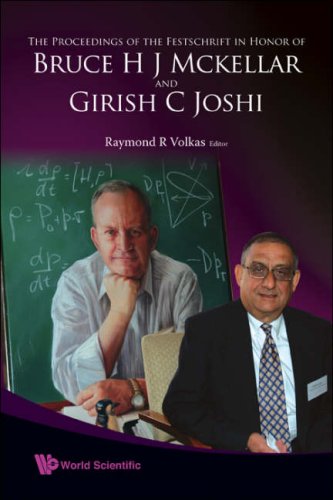

Most ebook files are in PDF format, so you can easily read them using various software such as Foxit Reader or directly on the Google Chrome browser.
Some ebook files are released by publishers in other formats such as .awz, .mobi, .epub, .fb2, etc. You may need to install specific software to read these formats on mobile/PC, such as Calibre.
Please read the tutorial at this link: https://ebookbell.com/faq
We offer FREE conversion to the popular formats you request; however, this may take some time. Therefore, right after payment, please email us, and we will try to provide the service as quickly as possible.
For some exceptional file formats or broken links (if any), please refrain from opening any disputes. Instead, email us first, and we will try to assist within a maximum of 6 hours.
EbookBell Team

0.0
0 reviews
ISBN 10: 9812708545
ISBN 13: 9789812708540
Author: Raymond R Volkas
These proceedings honor the long careers in theoretical particle physics of B H J McKellar and G C Joshi, who established theoretical particle physics research at the University of Melbourne.
Photographs
Three Nucleon Forces and Nuclear Structure B. R. Barrett
1. Introduction
2. The Signi.cance of Three-Nucleon Interactions
3. The No-Core Shell Model (NCSM)
4. Testing Di.erent Theoretical NNN Interaction Models
5. Conclusions
Acknowledgments
References
How Magnetic is the Neutrino? N. F. Bell
1. Introduction
2. Dirac Neutrinos
3. Majorana Neutrinos
3.1. SU(2) gauge boson
3.2. Hypercharge gauge boson
3.2.1. 7D mass term — OB
3.2.2. 5D mass term — OB
3.3. Comparison with experimental limits
4. Conclusions
Acknowledgments
References
Anions and Anomalies M. Bawin, S. A. Coon. and B. R. Holstein
1. Introduction
2. Regularization of the 1/r2 Potential
2.1. An alternate picture
3. An Explanation
4. Conclusion
Acknowledgments
References
Property Values R. Delbourgo
Preamble
1. Introduction
2. Property Super.elds
3. Exotic Particles, Generations and the Mass Matrix
4. Generalized Relativity
5. Some Notational Niceties
6. Curvatures of Space-Time-Property
Acknowledgments
References
Interacting Bose Gas Con.ned by an External Potential G. Gnanapragasam and M. Das*
1. Introduction
2. Hamiltonian
3. Double-Time Temperature-Dependent Green Functions
4. Equation of Motion
4.1. Solution in lowest order
5. Specific Heat of Trapped Interacting Bose Gas in the Quasi-Continuum Limit
6. Conclusion
References
Variation of the Fundamental Constants: Theory and Observations V. V. Flambaum
1. Introduction
2. Optical Spectra
2.1. Comparison of quasar absorption spectra with laboratory spectra
2.2. Optical clocks
3. Enhanced Effects of a Variation in Atoms
4. Enhanced Effects of a Variation in Molecules
5. Variation of the Strong Interaction
6. Microwave Clocks
7. Enhanced E.ect of Variation of a and Strong Interaction in UV Transition of 229Th Nucleus (Nuclea
8. Enhancement of Variation of Fundamental Constants in Ultracold Atom and Molecule Systems Near Fes
9. Changing Physics Near Massive Bodies
Acknowledgments
References
Mirror Dark Matter R. Foot
Acknowledgments
References
Analytic, Non-Perturbative, Almost-Exact QED: The Two-Point Function H. M. Fried
References
Sterile Neutrinos in a 6 × 6 Matrix Approach T. Goldman
1. Quark-Lepton Symmetry is Our Basis
2. See-Saw Mechanism
2.1. An early effort
3. Weyl Spinors
3.1. Lagrangian density for massive Weyl spinors
3.2. Equations of motion and form of solutions
3.3. Majorana and Dirac bispinors
4. Beyond the Simple See-Saw: Reduced Rank
4.1. Analytic analysis of two flavor case
4.2. Results for three flavor case
4.3. One detector or two?
5. Conclusion
Acknowledgments
References
Particle Physics in Condensed Matter C. Hamer
1. Introduction
2. Quantum Lattice Models
3. Quantum Phase Transitions
4. Quasiparticle Energy Spectra
5. “Deep Inelastic” Scattering
6. Confinement
7. Conclusions
References
CP Violation X.-G. He
1. Introduction
2. CP Violation
3. Conclusion
Acknowledgments
References
Quantum Computation in Silicon — Device Modeling, Transport and Fault-Tolerance L. C. L. Hollenber
1. Introduction
2. Donor Based Qubits in Silicon
3. Donor Qubit Spin System
4. Device Modeling – General Considerations
5. Exchange Oscillations
6. Microwave Driven P-P+ System
7. Coherent Transport in Donor Systems
8. Quantum Computer Architectures and Beyond
Acknowledgments
References
Born Reciprocity in Two Dimensions: Quaplectic Group Symmetry, Branching Rules and State Labelling P
1. Introduction
2. Two Dimensional Reciprocal Relativity
3. Quaplectic Group Branching and State Labelling in Two Dimensions
4. Conclusions
Acknowledgements
References
Quark-Lepton Symmetry and Quartification in Five Dimensions K. L. McDonald
1. Introduction
2. Quark-Lepton Symmetry
3. QL Symmetry in Five Dimensions
4. Quartification in Five Dimensions
5. Conclusion
References
MSW in Reverse; What SNO Says about Pseudo-Dirac Neutrinos G. J. Stephenson, Jr.
1. Introduction
2. Standard Solar MSW
3. Pseudo-Dirac Neutrinos
4. Implications of SNO Data for Pseudo-Dirac Neutrinos
5. Ways Out
5.1. Fluctuations and vacuum oscillations
5.2. Reverse MSW
6. Conclusion
References
Looking Forward to the Large Hadron Collider G. N. Taylor
1. Introduction
2. Successes of the Standard Model
3. The Standard Model Higgs
4. The Large Hadron Collider
5. The ATLAS Experiment
6. First Measurements at the LHC
7. The Outlook
References
Some Recent Lattice QCD Results from the CSSM S. Boinpolli, P. O. Bowman, J. N. Hedditch, U. M. Hell
1. Introduction
2. Electromagnetic Structure of Octet and Decuplet Baryons
3. Hybrid and Exotic Mesons from FLIC Fermions
4. Quark and Gluon Propagators in Full QCD
5. Conclusions
Acknowledgments
the proceedings of the festschrift in honor of bruce
the procession of the months
bruce receives letter
f f bruce canon of scripture
proclamation bruce pearson
f.f. bruce the canon of scripture pdf
f.f. bruce hebrews pdf
Tags: Raymond R Volkas, Festschrift, Honor